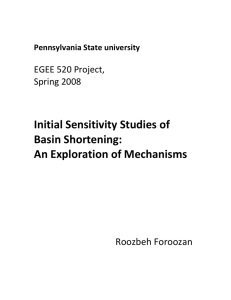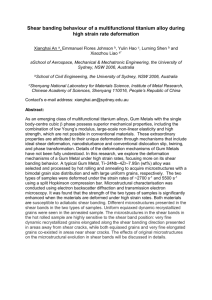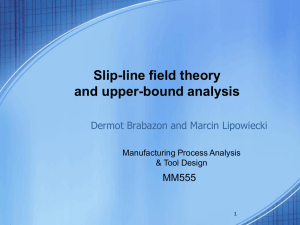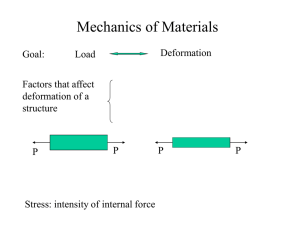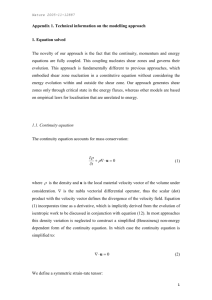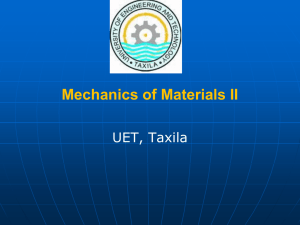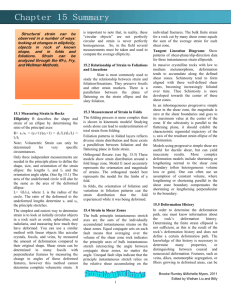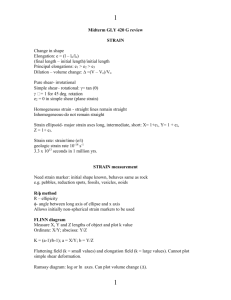Stress and Strain
advertisement
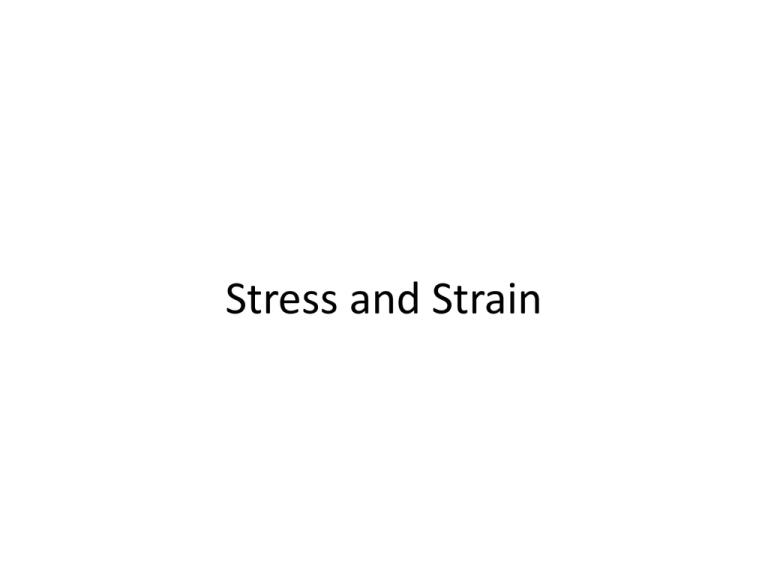
Stress and Strain Stress • • • • Force/Area Pressure is one form of Stress Units: Pascals (1 bar = 1 atm = 100,000 Pa) Normal Stress: Perpendicular to surface – Compression vs. Tension • Shear: Parallel to Surface Stress • Hydrostatic Stress (usually compressional) – Uniform in all directions. – A scuba diver experiences hydrostatic stress. – Stress in the earth is nearly hydrostatic. – The term for uniform stress in the earth is lithostatic. • Directed Stress – Varies with Direction Stress Sign Conventions • Positive = In Positive Coordinate Direction – Tension = Positive – Mostly used in Math and Engineering • Geological: Compression is Positive – Most geological stresses are compressional Friction • Downward Force Exerted by Object = gm • It generally takes less force to push the object sideways • Pushing Force/Downward Force = Coefficient of Friction • Static vs. Kinetic Friction • Static Friction usually greater Coefficient of Friction • • • • • Teflon on Teflon: 0.04 Steel on Steel, Lubricated: 0.16 Steel on Steel, Dry: 0.8 (Check your oil!) Tire on Concrete: 1.7 Geologic: 0.5+/– Some situations like thrust faulting seem to require much less Coefficient of Friction Friction • Fdown = (whx)dg • Fpush = (whx)dg * N • σpush = (whx)dg * N/wh = xdgN – Note h disappears! Thrusting a Thrust Fault • σpush = xdgN • x = 20 km, d = 2700 kg/m3, g = 9.8 m/sec2, N=0.5 • σpush = 20,000 * 2700 * 9.8 * 0.5 = 264 Mpa • Most rocks fail below this – Joints make rocks weaker – Many thrust sheets are wider than 20 km So Just How do Thrusts Move? • • • • • Gravity sliding Reduce friction Lifting with pressurized fluids Piecemeal motion (Adjusting a mattress) Many thrust sheets are on the edge of failure – Internal breakup (duplexing) • Confining pressure increases strength (thicker sheets stronger) Strain • Dimensionless (a ratio) – Deformation/Original Dimension • Longitudinal = Does not Change Direction of a Line – Compression or Tension • Shear = Changes Direction of a Line • Infinitesimal: Less than a few per cent – Permits convenient approximations • Finite: Larger than a few per cent Strain • Homogeneous Strain – – – – – Uniform strain. Straight lines in the original object remain straight Parallel lines remain parallel Circles deform to ellipses Note that this definition rules out folding, since an originally straight layer has to remain straight. • Inhomogeneous Strain – How real geology behaves – Deformation varies from place to place – Lines may bend and do not necessarily remain parallel. Behavior of Materials • Elastic Material deforms under stress but returns to its original size and shape when the stress is released. No permanent deformation. • Brittle Material deforms by fracturing (Glass) • Ductile Material deforms without breaking (Metals) • Viscous Deform steadily under stress (Fluids, Magma) • Plastic Material does not flow until a threshold stress has been exceeded. • Viscoelastic Combines elastic and viscous behavior. Models of glacio-isostasy frequently assume a viscoelastic earth: the crust flexes elastically and the underlying mantle flows viscously. Elastic Deformation • Analog: A Spring • Hooke’s Law: Deformation = k x Force • Young’s Modulus: E = Stress/Strain – Longitudinal Strain – Units = Pascals – Stress to produce 100% Strain – Typically 50-150 Gpa for Crystalline Rocks – Strain roughly 10-6/Bar – Elastic Strain generally infinitesimal Poisson’s Ratio • Ratio of Shear Strain to Longitudinal Strain • For most rocks, ranges from ¼ to 1/3 • Usually symbolized by Greek letter nu (ν), sometimes by sigma (σ) Other Elastic Parameters • There are really only two independent variables • Shear Modulus – G = shear stress/shear strain – G = E/2(1 + ν) – Since ν ranges from 1/4 to 1/3 for most rocks, G is about 0.4 E. Bulk Modulus • K = pressure/volume change • K = E/(3(1 - 2ν)) • Since v ranges from 1/4 to 1/3 for most rocks, K ranges from 2/3E to E. Viscous Deformation • Analog: Dashpot (Leaky piston) – Door closer – Access door openers – Shock absorbers • Viscosity N = (shear stress)/(shear strain rate) • Units = Pascal - Seconds Plastic Deformation • Analog = Sliding Block • Stress has to reach a threshold • Power Law Creep – Strain Rate = C (Stress)n exp(-Q/RT) – C = scaling constant – n = Strain rate goes up much faster than stress – Q = activation energy Power Law Creep Familiar Examples • Shear Thinning – Mayonnaise – Ball Point pen ink • Shear Thickening – Cornstarch and water – Liquid Armor Shear Strain Pure Shear Pure and Simple Shear Pure and Simple Shear Mohr Circles Mohr Circles and Real Space • Measure angles from the pole to the plane • All Mohr angles are twice real world angles • All angles are measured in the same sense in real space and Mohr space Stresses in Three dimensions • cos2A1 + cos2A2 + cos2A3 = 1 • These are called the direction cosines of the line • Proportional to 1/intercepts of the plane Mohr Circles in Three Dimensions Mohr Circles in Three Dimensions

